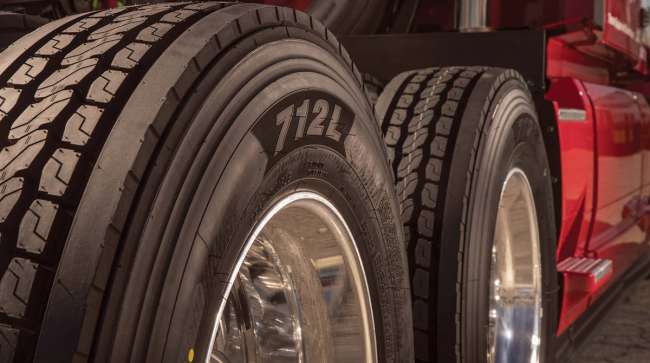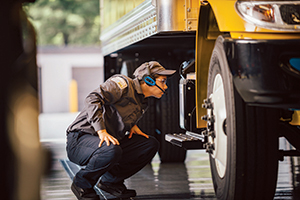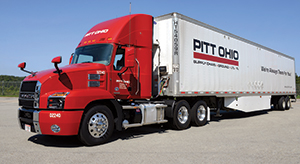Special to Transport Topics
Fleets’ Tire Choices Involve Many Factors

[Stay on top of transportation news: Get TTNews in your inbox.]
Selecting the right tires for a trucking fleet’s specific application and business model is both a science and an art, with experience, industry know-how and common sense mixed in.
Tire price, tread wear and fuel economy all factor into fleet managers’ decisions as they seek out the best tire specs for their tractors and trailers.
Lately, with average U.S. diesel prices climbing past the $3-per-gallon mark this year and approaching $4 in places such as California, fuel efficiency is becoming an even more important variable for tire selection.
Some trucking companies have outfitted their fleets with SmartWay-certified low-rolling-resistance tires to reduce fuel costs, despite trade-offs on tire price and tread depth.

Forte
“Right now, the return on investment in low-rolling-resistance tires is small, but it should grow as the cost of diesel rises,” said Nick Forte, chief maintenance officer at Dubuque, Iowa-based Hirschbach, which ranks No. 62 on the Transport Topics Top 100 list of the largest for-hire carriers in North America.
Apart from their effect on a fleet’s overall fuel economy, tires also represent a major maintenance expense for trucking companies.
“Tires are behind fuel and labor as an expense, but they are a strong No. 3,” said Taki Darakos, vice president of vehicle maintenance and fleet services for Pittsburgh-based regional carrier Pitt Ohio. “They play a large role in our financials.”
Pitt Ohio, which ranks No. 45 on the TT Top 100 for-hire carriers list, holds quarterly meetings with its tire suppliers and reviews performance data for the tires it has deployed in its fleet.
But managing expenses is only one aspect of effective tire management.

Darakos
“Safety is a core tenet of our business philosophy,” Darakos said. “Our drivers are aware of nails, screws and pallets at customer locations that may cause delays due to flats or other tire damage and throw us off schedule.”
Wide-base tires are one option that can improve fuel efficiency, but they may require more frequent replacement.
Hirschbach’s Forte said his company’s low-rolling-resistance wide-base drive tires are averaging 200,000 miles while its dual-drive tire replacements are logging 300,000 to 325,000 miles.
Scott Brower, vice president of vehicle supply at Penske Truck Leasing, manages a fleet of more than 328,000 trucks across North America with customers leasing anywhere from one to 1,000 trucks. The majority of customers lease fewer than 12 vehicles. He said Penske uses some wide-base low-rolling-resistance tires for fleet efficiency and regulatory compliance, but dual tires are the standard and the predominant type of tire in the Penske fleet.
“If a customer requests wide-base tires, we will provide wide-base, but low-rolling-resistance dual tires are what we use to be compliant with CARB [California Air Resources Board], SmartWay and greenhouse gas regulations,” Brower said.
In addition to the tire type and design, maintaining proper tire pressure also plays a significant role in fuel economy.
Penske uses technology to monitor tire pressure and has deployed an onboard system that can inflate or maintain inflation. Information from tire pressure sensors is transmitted back to Penske through telematics.
Apart from tires, there are many other ways for fleets to cut fuel costs.

To manage tire maintenance costs, Penske, for instance, uses technology to monitor tire pressure and has deployed an onboard system that can inflate or maintain inflation. (Penske)
Penske measures savings from vehicle aerodynamics, light weighting specs, air disc brakes, aluminum wheels, aluminum air tanks, fuel capacity, automated manual transmissions, smaller engines and faster rear axle ratios.
Hirschbach, meanwhile, uses tire pressure sensors, FA-4 engine oil, certain drivetrains, aerodynamic sideskirts, wheel covers and predictive cruise control to help reduce fuel consumption.
Although fuel efficiency is important, it is not the highest priority for all fleets.
Doug Lloyd is director of maintenance for Averitt Express, a less-than-truckload carrier based in Cookeville, Tenn., that operates in 18 states across the Southeast.
“We look at total cost, and tire wear drives the numbers, not fuel economy,” he said. “As an LTL carrier, we need robust tires and fuel economy is a benefit.”
Lloyd said tire costs rank third in total company costs behind fuel and labor. Within the maintenance department, however, tires are the largest line item on the balance sheet.

Carrier Pitt Ohio regularly meets with its tire suppliers and reviews its fleet’s tire performance data. (Pitt Ohio)
His company works closely with its tire supplier, Michelin, and truck makers Freightliner and Volvo to utilize the best tires and equipment for Averitt’s business applications.
Averitt ranks No. 32 on the TT Top 100 for-hire carriers list.
Other fleet managers also work closely with their tire suppliers to help reduce tire program costs.
Gary Schroeder, executive director of Cooper Tire’s global truck and bus tire business, said some fleets emphasize fuel economy while others are willing to sacrifice some fuel efficiency to maximize tire life.
Cooper works with fleets to analyze their tire options through a total-cost-of-ownership formula that considers tire price, fuel efficiency, mileage and the casing value.
“Knowing these four factors and comparing the numbers across brands allows the fleet manager to make informed, fact-based decisions on replacing worn tires,” Schroeder said.
Dan Funkhouser, vice president of commercial sales at Yokohama Tire, says fleet managers’ priorities often include long-wearing tires, casing value and retreadability, fuel efficiency, product availability and cost.

Even before the pandemic, DHL's Larry S. Onge and Jim Monkmeyer set up strategies and implemented technology in order to respond to disruptions. Now, they know exactly how to get the vaccine from point A to point B — and, better, how to do it at a global scale. Hear a snippet, above, and get the full program by going to RoadSigns.TTNews.com.
“We offer products that deliver long original-wear miles and fuel efficiency,” Funkhouser said. “Plus, we are available through our extensive dealer network and truck stops and OE partners. We use dependable and retreadable casing, all of which leads to a lower overall cost-per-mile and total cost of ownership.”
While many fleets rely on in-house testing and contributions from their tire manufacturers to assess and analyze their tire programs, some use third-party, outside sources to measure their fleet’s tire and fuel efficiency.
Hirschbach’s Forte is a disciple of the testing regimen devised by former Indy Lights racing engineer Daryl Bear, lead engineer and chief operating officer at MVT Solutions, a subsidiary of trucking company Mesilla Valley Transportation.
After going to work for the parent company, Bear saw an opportunity to apply what he had learned in Indy racing to improve performance and fuel mileage for commercial carriers.
To provide a more accurate assessment of potential fuel savings, MVT Solutions measures gallons of fuel consumed per 1,000 miles rather than the percentage of fuel used in the fuel tank in a standard miles-per-gallon metric. The total amount of fuel changes, Bear said, so the percentage changes. Offering a comparison, MVT indicates the percentage of fuel saved alongside the gallons consumed per 1,000 miles.
Mesilla Valley Transportation, based in Las Cruces, N.M., ranks No. 78 on the TT Top 100 for-hire carriers list.

Roeth
While fleet managers today have different approaches to tire selection, fuel economy and other factors shaping their business and equipment decisions, the rising cost of diesel looms over the industry and the ongoing economic recoveries at the local, state and national levels.
Mike Roeth, executive director of the North American Council for Freight Efficiency, said rising fuel prices will galvanize the industry to fully support low-rolling-resistance tires, despite their shallower tread depth.
“When fuel hits $4 a gallon, efficiencies will become important,” he predicted. “Depth of tread helps traction and wear, but higher tread is worse for fuel economy. Less tread depth is better for fuel economy. Lately engineers at tire manufacturers have been doing good work combining fuel economy, traction and wear.”
Want more news? Listen to today's daily briefing below or go here for more info:

